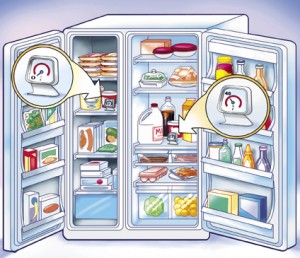Activity: Keep-A-Cube

Activity from WGBH Educational Foundation’s ZOOM into Engineering and featured on the DiscoverE site. Click HERE for PDF.
Grade level: K-8
Time: 60 minutes
Summary
In this activity, student teams in grades K – 6 explore the design process by engineering a way to keep an ice cube from melting for 30 minutes.
Engineering Motivation
Refrigeration is considered one of engineering’s greatest 20th-century achievements. Until the 1920s, meat and milk had to be purchased on a daily basis, and only the only fruit and vegetables were those grown locally, in season. Families with iceboxes could keep some perishables for two or three days, thanks to weekly deliveries of ice blocks—harvested in winter from frozen northern lakes. 
Mechanical refrigeration, that cools food through a closed system of circulating refrigerant driven by a compressor, first came on the scene in 1913. In that year, an inventor named Fred Wolf introduced a household refrigerator that ran on electricity. He called it the Domelre, for Domestic Electric Refrigerator, and sold it for $900. It was a quick hit but was merely an adaptation of the old icebox that it was designed to be mounted on top of.
Two years later, Alfred Mellowes introduced the first self-contained mechanical refrigerator, but it was a commercial flop. Enter William Durant, president of General Motors, who saw the potential of the product and bought the company in 1918, renaming it Frigidaire and putting some of GM’s best engineering and manufacturing minds to work on mass production.
Materials
For each team
- 2 ice cubes
- 1 cardboard box (less than one cubic foot; shoe boxes work well)
- waxed paper
- masking tape
- newspaper
- aluminum foil
- rubber bands
- paper plate or plastic bowl to hold ‘control’ ice cube
Procedure
1. Ask students what makes ice melt? Heat! Lead class discussion to conclude that the air around the ice cube is warmer than the ice, so they need to keep the warm air away from the ice cube. Insulation is a material that slows heat energy from passing through it.
2. Using the materials, have students make a container that can keep an ice cube from melting. Tell them they can wrap up the ice cube, cover the box, or do anything else they can think of to insulate the ice cube. What works best to keep heat away from the ice cube? Wrapping the box in aluminum foil? Suspending the cube?
3. Have students put their ice cubes in their containers at the same time. Take another ice cube and place it on the paper plate or in the plastic bowl and leave it outside the Keep-a-Cube container. That is the control ice cube.
4. Wait 30 minutes. Compare the ice cube in the Keep-a-Cube box to the one on the plate or in the bowl. Which ice cube is bigger? Why? If the two ice cubes are the same size, the Keep-a-Cube container didn’t do much to keep its contents from melting!
Extensions
Have the kids brainstorm other designs. How could they change the container so the ice cube melts more slowly?
If there’s time, have students repeat the activity with other insulating materials, such as foam packing peanuts or cotton balls, or a different size box. Choose one thing to change (the variable) and make a prediction (hypothesis). Then test again.
See the Keep-A-Cube ZOOM into Engineering episode [YouTube 5:59]
Filed under: Class Activities, Grades 6-8, Grades K-5
Tags: Class Activities, Design, Grades K-5, ice cube, insulation, refrigeration








